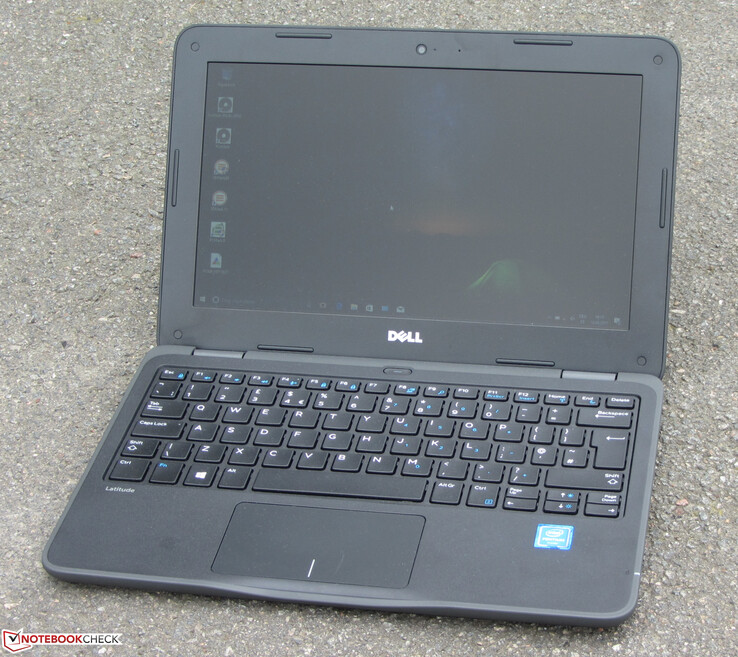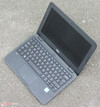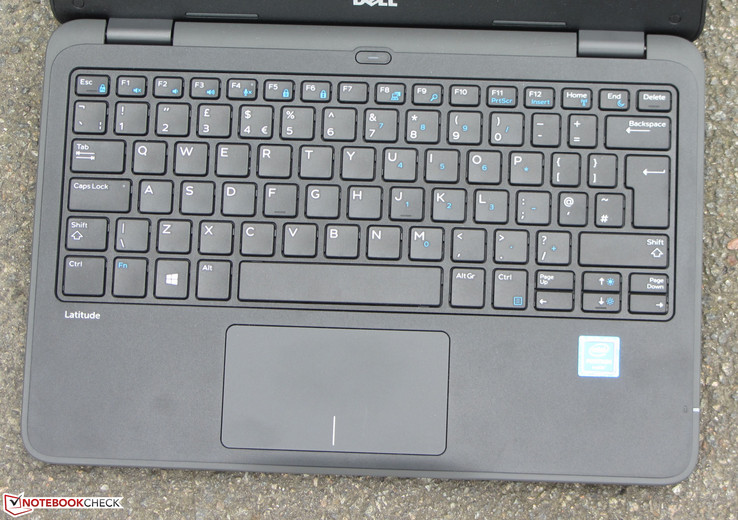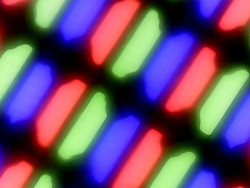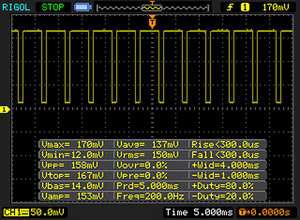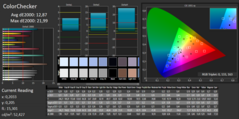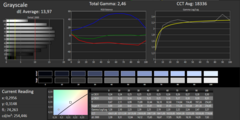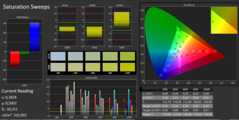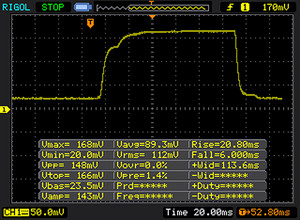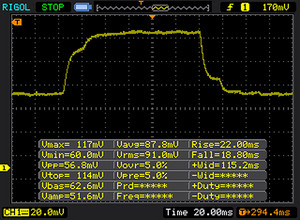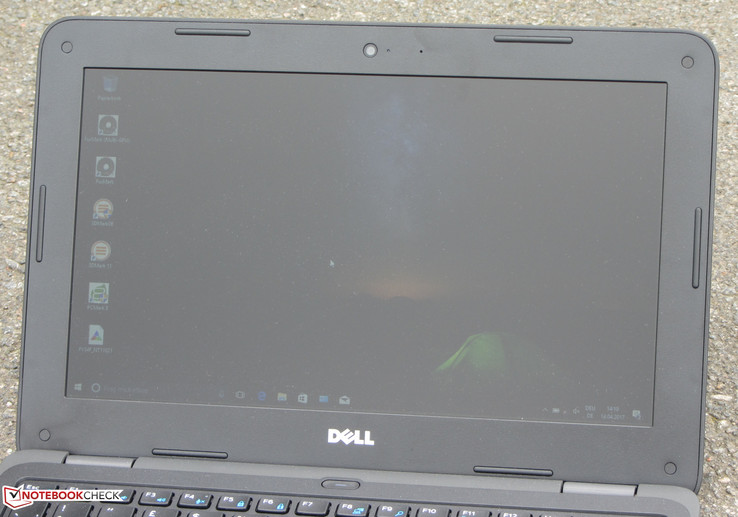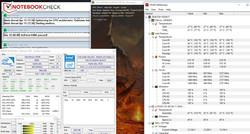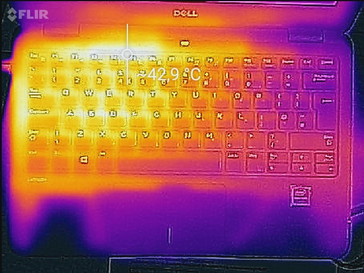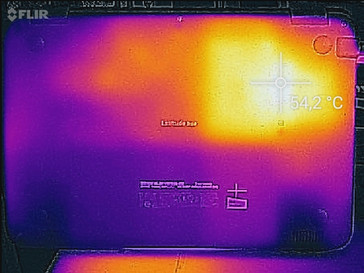Test laptopa Dell Latitude 3180
Tekst i zdjęcia: Sascha Mölck
Wstęp i tłumaczenie: Tomasz Cyba
30/04/2017
Dell Latitude 3180 to mały laptop przeznaczony do użytku szkolnego, wyposażony w procesor Apollo Lake. Nie posiada wentylatora i mechanicznego dysku (zamiast niego ma SSD lub eMMC), w związku z czym jest bezgłośny.
Obudowa
Dell Latitude 3180 ma czarną, matową obudowę wykonaną z plastiku. Jej powierzchnie są trochę chropowate. Jednostka zasadnicza ma gumowe obrzeże, które ma chronić komputer przed uderzeniami. Sztywność obudowy nie przedstawia się najlepiej. Jednostka zasadnicza wykrzywia się w zbyt dużym stopniu. Nawet przy lekkim nacisku na dekiel występują zaburzenia w wyświetlanym obrazie.
Akumulator znajduje się wewnątrz obudowy. By się do niego dostać, trzeba zdjąć cały spód jednostki zasadniczej.
Porty peryferyjne nie są liczne. Omawiany laptop posiada m.in. dwa USB typu A (3.1 Gen 1) i HDMI. Złącza nie są dobrze rozlokowane - znajdują się na ściankach bocznych na wysokości podnadgarstnika.
Osprzęt
Latitude 3180 posiada wyspową, niepodświetlaną klawiaturę. Klawisze są nieco wklęsłe i mają szorstką powierzchnię. Ich skok jest krótki.
Płytka dotykowa ma wymiary około 10 x 5,6 cm. Jej gładka powierzchnia sprzyja szybkiemu przesuwaniu po niej palca. Zintegrowane z płytką przyciski mają krótki skok.
Obraz
| |||||||||||||||||||||||||
rozświetlenie: 85 %
na akumulatorze: 253 cd/m²
kontrast: 538:1 (czerń: 0.47 cd/m²)
ΔE ColorChecker Calman: 12.87 | ∀{0.5-29.43 Ø4.78}
ΔE Greyscale Calman: 13.97 | ∀{0.09-98 Ø5}
61% sRGB (Argyll 1.6.3 3D)
39% AdobeRGB 1998 (Argyll 1.6.3 3D)
42.13% AdobeRGB 1998 (Argyll 3D)
61.4% sRGB (Argyll 3D)
40.78% Display P3 (Argyll 3D)
Gamma: 2.46
CCT: 18336 K
Migotanie ekranu / PWM (modulacja szerokości impulsu)
| Wykryto migotanie ekranu/wykryto PWM | 200 Hz | ≤ 90 % ustawienia jasności | |
Podświetlenie wyświetlacza miga z częstotliwością 200 Hz (najgorszy przypadek, np. przy użyciu PWM) Wykryto migotanie przy ustawieniu jasności 90 % i poniżej. Powyżej tego ustawienia jasności nie powinno być żadnego migotania ani PWM. Częstotliwość 200 Hz jest stosunkowo niska, więc wrażliwi użytkownicy prawdopodobnie zauważą migotanie i odczują zmęczenie oczu przy podanym ustawieniu jasności i poniżej. Dla porównania: 53 % wszystkich testowanych urządzeń nie używa PWM do przyciemniania wyświetlacza. Jeśli wykryto PWM, zmierzono średnio 8101 (minimum: 5 - maksimum: 343500) Hz. | |||
Wyświetl czasy reakcji
| ↔ Czas reakcji od czerni do bieli | ||
|---|---|---|
| 26 ms ... wzrost ↗ i spadek ↘ łącznie | ↗ 20 ms wzrost | |
| ↘ 6 ms upadek | ||
| W naszych testach ekran wykazuje stosunkowo powolne tempo reakcji i może być zbyt wolny dla graczy. Dla porównania, wszystkie testowane urządzenia wahają się od 0.1 (minimum) do 240 (maksimum) ms. » 61 % wszystkich urządzeń jest lepszych. Oznacza to, że zmierzony czas reakcji jest gorszy od średniej wszystkich testowanych urządzeń (20.2 ms). | ||
| ↔ Czas reakcji 50% szarości do 80% szarości | ||
| 40 ms ... wzrost ↗ i spadek ↘ łącznie | ↗ 22 ms wzrost | |
| ↘ 18 ms upadek | ||
| W naszych testach ekran wykazuje powolne tempo reakcji, co będzie niezadowalające dla graczy. Dla porównania, wszystkie testowane urządzenia wahają się od 0.165 (minimum) do 636 (maksimum) ms. » 60 % wszystkich urządzeń jest lepszych. Oznacza to, że zmierzony czas reakcji jest gorszy od średniej wszystkich testowanych urządzeń (31.6 ms). | ||
Osiągi
Testowany egzemplarz był wyposażony w czterordzeniowy procesor Intel Pentium N4200 (Apollo Lake). Ma on niskie TDP (6 W), co umożliwia zastosowanie pasywnego chłodzenia. Tak właśnie jest w omawianym laptopie. Bazowa częstotliwość taktowania CPU to 1,1 GHz. Turbo Boost zwiększa taktowanie do 2,5 GHz. W testach Cinebench R15 procesor ten uzyskał wyniki o 17-21% lepsze od wyników procesora Pentium N3710 (Braswell) z laptopa Acer TravelMate B117-M. W półgodzinnym teście wielowątkowym puszczonym w pętli rezultaty poszczególnych prób były zbliżone do siebie.
Układ grafiki zintegrowany z procesorem to HD Graphics 505. Ma 18 jednostek wykonawczych a jego taktowanie to 750 MHz. W teście 3DMark 11 zapewnił on omawianemu laptopowi rezultat znacznie lepszy, niż ten, który był udziałem wspomnianego Acera B117-M z układem HD Graphics 405. Jego przewaga wyniosła aż 74% (825 vs 473 pkt.). Wynik bohatera niniejszej recenzji jest także dużo lepszy od osiągnięć Acerów Aspire ES1-332 i Aspire ES1-533, modeli również wyposażonych w procesor Pentium N4200 z układem HD 505. Być może wynika to z dwukanałowego trybu pracy pamięci RAM w omawianym laptopie (programy diagnostyczne CPU-Z i HWiNFO nie dostarczyły informacji na ten temat).
| Cinebench R15 | |
| CPU Single 64Bit | |
| Acer Aspire ES1-332-P91H | |
| Acer Aspire ES1-533-P7WA | |
| Dell Latitude 3180 | |
| Dell Latitude 3189 | |
| Acer TravelMate B117-M-P16Q | |
| Dell Latitude 11 3150 | |
| HP Stream 11-r000ng | |
| CPU Multi 64Bit | |
| Dell Latitude 3180 | |
| Dell Latitude 3189 | |
| Acer Aspire ES1-332-P91H | |
| Acer Aspire ES1-533-P7WA | |
| Dell Latitude 11 3150 | |
| Acer TravelMate B117-M-P16Q | |
| HP Stream 11-r000ng | |
| Cinebench R10 | |
| Rendering Multiple CPUs 32Bit | |
| Dell Latitude 3180 | |
| Dell Latitude 3189 | |
| Acer Aspire ES1-332-P91H | |
| Acer Aspire ES1-533-P7WA | |
| Acer TravelMate B117-M-P16Q | |
| Dell Latitude 11 3150 | |
| Rendering Single 32Bit | |
| Acer Aspire ES1-332-P91H | |
| Acer Aspire ES1-533-P7WA | |
| Dell Latitude 3180 | |
| Dell Latitude 3189 | |
| Dell Latitude 11 3150 | |
| Acer TravelMate B117-M-P16Q | |
| Geekbench 3 | |
| 32 Bit Single-Core Score | |
| Dell Latitude 3180 | |
| Acer Aspire ES1-533-P7WA | |
| Acer Aspire ES1-332-P91H | |
| Acer TravelMate B117-M-P16Q | |
| 32 Bit Multi-Core Score | |
| Dell Latitude 3180 | |
| Acer Aspire ES1-533-P7WA | |
| Acer Aspire ES1-332-P91H | |
| Acer TravelMate B117-M-P16Q | |
| Geekbench 4.0 | |
| 64 Bit Single-Core Score | |
| Acer Aspire ES1-533-P7WA | |
| Acer Aspire ES1-332-P91H | |
| Dell Latitude 3180 | |
| 64 Bit Multi-Core Score | |
| Dell Latitude 3180 | |
| Acer Aspire ES1-533-P7WA | |
| Acer Aspire ES1-332-P91H | |
| Geekbench 4.4 | |
| 64 Bit Single-Core Score | |
| Dell Latitude 3180 | |
| 64 Bit Multi-Core Score | |
| Dell Latitude 3180 | |
| JetStream 1.1 - Total Score | |
| Acer Aspire ES1-533-P7WA | |
| Acer Aspire ES1-332-P91H | |
| Dell Latitude 3180 | |
| Dell Latitude 3189 | |
| Acer TravelMate B117-M-P16Q | |
| PCMark 8 Home Score Accelerated v2 | 2314 pkt. | |
Pomoc | ||
| PCMark 8 - Home Score Accelerated v2 | |
| Dell Latitude 3180 | |
| Acer TravelMate B117-M-P16Q | |
| HP Stream 11-r000ng | |
| Medion Akoya S2218 | |
Testowany Dell został wyposażony w dysk SSD M.2 2280 marki LiteOn. Jego nominalna pojemność to 128 GB a w stanie fabrycznym użytkownik ma do dyspozycji około 86 GB przestrzeni dyskowej. Prędkości transferu danych w testach syntetycznych okazały się dobre [aczkolwiek zapis sekwencyjny w testach AS SSD i CDM oraz odczyt 4K w obu tych programach prezentują się raczej słabo - przyp. tłum.].
| Dell Latitude 3180 Liteonit CV3-8D128 | Dell Latitude 11 3150 Samsung SSD PM851 128 GB MZ7TE128HMGR | Acer TravelMate B117-M-P16Q Liteonit CV3-8D256 | HP Stream 11-r000ng 32 GB eMMC Flash | Medion Akoya S2218 64 GB eMMC Flash | |
|---|---|---|---|---|---|
| CrystalDiskMark 3.0 | -25% | 25% | -58% | -67% | |
| Read Seq (MB/s) | 482.6 | 251.5 -48% | 506 5% | 154.2 -68% | 140.2 -71% |
| Write Seq (MB/s) | 213.2 | 124.4 -42% | 393.4 85% | 76.6 -64% | 52.7 -75% |
| Read 512 (MB/s) | 276.5 | 229.2 -17% | 329.1 19% | 165.8 -40% | 98.4 -64% |
| Write 512 (MB/s) | 162.6 | 124.8 -23% | 282.5 74% | 59.9 -63% | 58.7 -64% |
| Read 4k (MB/s) | 18.17 | 13.5 -26% | 23.35 29% | 18.25 0% | 15.25 -16% |
| Write 4k (MB/s) | 44.77 | 39.21 -12% | 45.56 2% | 13.16 -71% | 9.817 -78% |
| Read 4k QD32 (MB/s) | 132.7 | 117.4 -12% | 123.5 -7% | 46.51 -65% | 37.24 -72% |
| Write 4k QD32 (MB/s) | 118.1 | 98.6 -17% | 111.2 -6% | 13.21 -89% | 8.734 -93% |
| 3DMark 11 Performance | 899 pkt. | |
Pomoc | ||
| 3DMark 11 - 1280x720 Performance GPU | |
| Dell Latitude 3180 | |
| Acer Aspire ES1-533-P7WA | |
| Acer Aspire ES1-332-P91H | |
| Acer TravelMate B117-M-P16Q | |
| HP Stream 11-r000ng | |
| Dell Latitude 11 3150 | |
| low | med. | high | ultra | |
|---|---|---|---|---|
| BioShock Infinite (2013) | 32.3 | 18.6 | 16.2 | |
| Deus Ex Mankind Divided (2016) | 5.1 | |||
| Resident Evil 7 (2017) | 14.4 | |||
| For Honor (2017) | 12.1 | |||
| Ghost Recon Wildlands (2017) | 5.9 |
Wpływ na otoczenie
Hałas
Latitude 3180 nie posiada wentylatora, więc nie emituje szumu. Innych odgłosów też nie było słychać.
Temperatury
W teście pełnego obciążenia (Prime95 plus FurMark) taktowanie CPU wynosiło początkowo 1,8-2 GHz a taktowanie GPU - 450 MHz. Po godzinie trwania testu taktowanie CPU miało wartość 1,5-1,6 GHz a taktowanie GPU - 250 MHz. Temperatura procesora osiągnęła 87°C. Obudowa była miejscami gorąca. Najwyższe zmierzona temperatura to w jej przypadku 48,4°C.
(±) Maksymalna temperatura w górnej części wynosi 40.6 °C / 105 F, w porównaniu do średniej 35.9 °C / 97 F , począwszy od 21.4 do 59 °C dla klasy Subnotebook.
(-) Dno nagrzewa się maksymalnie do 48.4 °C / 119 F, w porównaniu do średniej 39.3 °C / 103 F
(+) W stanie bezczynności średnia temperatura górnej części wynosi 23.2 °C / 74 F, w porównaniu ze średnią temperaturą urządzenia wynoszącą 30.8 °C / ### class_avg_f### F.
(+) Podpórki pod nadgarstki i touchpad są chłodniejsze niż temperatura skóry i maksymalnie 27.1 °C / 80.8 F i dlatego są chłodne w dotyku.
(±) Średnia temperatura obszaru podparcia dłoni w podobnych urządzeniach wynosiła 28.2 °C / 82.8 F (+1.1 °C / 2 F).
Głośniki
Głośniki znajdują się na spodzie obudowy. Wytwarzają one przyzwoity dźwięk, który jednak bywa czasem blaszany. Głośność maksymalna jest dość niska.
Wydajność akumulatora
W teście symulującym korzystanie z internetu przez Wi-Fi omawiany laptop działał (w trybie zrównoważonym) 10 godzin i 21 minut.
| wyłączony / stan wstrzymania | |
| luz | |
| obciążenie |
|
Legenda:
min: | |
| Battery Runtime - WiFi Websurfing | |
| Dell Latitude 3180 | |
| Dell Latitude 11 3150 | |
| Acer TravelMate B117-M-P16Q | |
| HP Stream 11-r000ng | |
| Medion Akoya S2218 | |
Za
Przeciw
Podsumowanie
Latitude 3180 to mały laptop pomyślany jako komputer dla szkół. Ma więc obudowę zabezpieczoną gumą przed obijaniem. Procesor Apollo Lake jest wystarczająco wydajny do podstawowych aplikacji użytkowych i korzystania z internetu. Omawiany laptop jest bezgłośny. Dzięki dyskowi SSD ten komputer jest szybki w działaniu. Nie wszystkie wersje Latitude 3180 posiadają SSD - niektóre są wyposażone w wolniejszy dysk eMMC. Jednym z minusów omawianego laptopa jest matryca o słabych parametrach. W komputerze przeznaczonym dla uczniów nie powinno występować migotanie obrazu.




